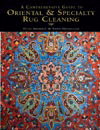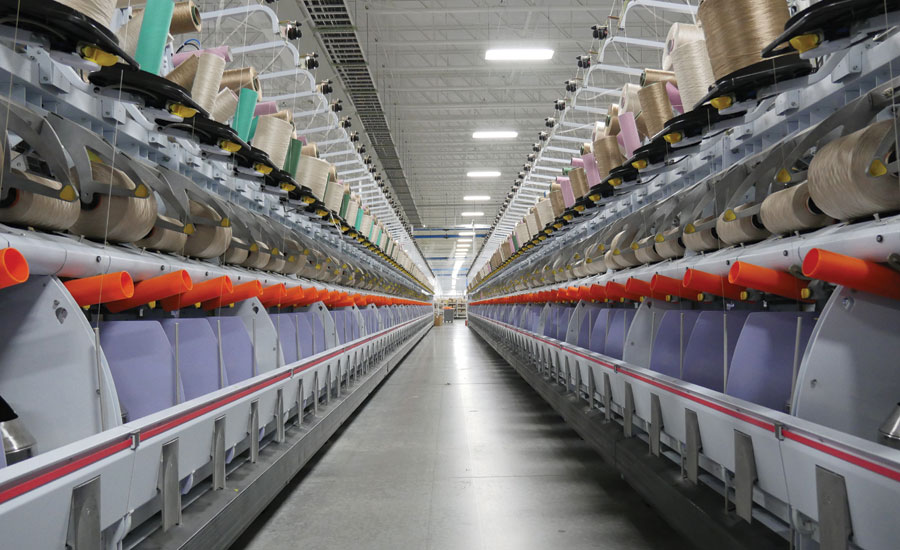Fiber 101: The Amazing Story of Fiber in the Carpet Industry

Engineered Floors vertically integrated its business model into fiber spinning and the production of polypropylene fiber.



The fiber story is a story of innovation that has taken place within the fiber sector of the carpet industry and it’s really the story of the carpet industry. Looking back, fiber developments have marked some of the central developments for carpet, not only as they relate to carpet the product but also with the companies that produce that carpet. As the major component of carpet, the product fiber developments have been the precursor of transformations that have occurred not only with the companies that have manufactured carpet but also the players that have historically produced that fiber for all U.S. carpet mills.
To get a handle on this 60-year story of fiber in the carpet industry, we sat down with Dr. Bob Peoples, executive director of Carpet America Recovery Effort (CARE) and former director of nylon technology at Solutia. The following are excerpts from that conversation. You are invited to watch the interview in its entirety in the archives on TalkFloor.com.
TF: I think it’s fair to say that the lion’s share of innovation that has taken place with carpet has occurred within the fiber sector. Is that an accurate statement?
Peoples: I think that’s a fair statement. If you look back at the very beginning, natural fibers, wool and cotton were the basis for all of our textiles, and pretty sophisticated manufacturing systems were developed to manipulate those fibers and make yarns and convert them into fabrics. With the advent of synthetic fibers, developed through the DuPont Labs with Wallace Carothers, they were able to spin for the first time polymers that were made from synthetic materials, which came from oil. They were able to spin those fibers and chop them into lengths that matched the lengths of natural fibers, called staple, so they could be placed into natural fiber spinning systems. It was an easy substitute for the existing equipment that was already in place. Synthetic fibers brought the advantage of consistency, stable quality and a reduction in price. As the scale of synthetic fibers rose, the price fell. Synthetic fibers actually resolved some of the deficiencies of natural fibers.
TF: You had mentioned that at the time of the development of synthetic fiber, machinery was developed to handle staple fiber. When did the shift to BCF (bulk continuous filament) fiber occur?
Peoples: That transition began to take place in the early 70s. When they extruded the first fibers that were continuous fibers, no one was able to process them, so eventually the technology advanced to companies that were able to handle a continuous stream of fiber. BCF clearly dominates the industry today.
TF: There are two varieties of nylon — 6 and 6,6. Talk about these two different kinds and the differences.
Peoples: There is a fundamental difference. When we talk about nylon 6, the six represents the basic building block of the polymer that is melded and extruded into a fiber. It’s one single building block and it contains six carbon atoms. Nylon 6,6 has two different building blocks, both of which have six carbon atoms. When a polymer is made from each of these basic materials, the result is different fundamental properties. They still have the properties that are referred to as nylon, but nylon 6 has a more open structure, which means it’s easier for things like dyes to go into them. It’s easier for things like ozone or nitrous oxide from the atmosphere to get in, and when they get in, they turn the fiber yellow.
Nylon 6,6, because of its crystalline structure, is a little tighter and more resistant to those kind of behaviors. Both have excellent resilient properties because of their chemical structure. You can compare and contrast that to fibers like polypropylene and polyester, and because of their molecular structure, they do not have the resiliencies that nylon has. So, when one steps on nylon 6 or 6,6 it tends to snap back and over years of traffic you still have that decent fiber look. Whereas with polyester, and in particular polypropylene, it tends to stay down, so it mats down and that’s what you would see in terms of performance. It’s also why nylon and nylon 6,6 in particular became the dominant fiber for commercial applications where you have very high foot traffic demands.
TF: The shape of the nylon fiber being extruded is an important characteristic as it relates to the properties of the finished carpet. Is there a variety of different shapes of nylon fiber used in carpet?
Peoples: Shape is important due to the physics of light reflection and refraction. When fibers were first extruded for carpet, they were round, with the result being a pure surface area from which light would reflect or enter the fiber and refract out. Fiber physicists learned early on that if the surface area of the fiber was changed, you could hide dirt on the surface of the fiber until the cleaning process. One of the earlier cross sections was the trilobal surface. Eventually, DuPont developed the square hollow cross section that has a square fiber with four channels running the length of the fiber, and that dramatically effects how light reflects and refracts from the surface. The trilobal cross section, which is a little easier to spin than the hollow cross sections, is the most common. The square hollow cross section is still very common in high-end commercial materials.
TF: Since the 1950s, there have been a number of developments in the fiber sector. Talk about some of the developments that are the most prominent and the ones we see a great deal of today.
Peoples: The evolution of fiber technology was pretty dramatic in the early days. It was driven for the most part by the four big fiber producers: Monsanto, DuPont, Allied and BASF. In those early days, these four large suppliers furnished all of the fiber that was used to make carpet, and the mills bought that as a raw material. There were over 600 mills, so no individual mill had critical mass to really drive the agenda. They relied on the fiber producers to supply all of the innovation. That changed with consolidation that began in the 1980s and really took off in the late 1980s and early 1990s.
The big innovations were centered in the area of the cross section of the fiber, which impacts the ability to hide soiling. TiO2 (Titanium Dioxide) as a delustrant was used to remove the shiny surface from the fiber that gave it a cheap plastic look, giving it a more woolen look. In the mid to late 1980s, the stain blocker revolution took place. Nylon dominated the fiber market, but nylons had the propensity to stain, especially with acid dyes. Acid dyes were commonly used to dye nylon, so a stain that contained an acid dye, such as red dye Kool Aid, would also act as a dye. Monsanto led the initial development of stain blocker technology, where it was either added as an element of the fiber or applied to the surface. This chemistry would resist the penetration of acid dyes, revolutionizing the residential market for a number of years, providing a springboard for the growth of stain resistant carpet in the late 1980s and early 1990s.
But a funny thing happened along the way: the producers of polypropylene recognizing that their chemistries were inherently stain resistant. As a result, Amoco decided to launch a product called Geneses for a cut-pile Saxony polypropylene based carpet. It was an enormous flop in the market place. As I mentioned earlier, polypropylene really lacks resiliency. When it was subjected to foot traffic it just laid down. Amoco had invested a great deal of money in the product and now faced an asset liability, realizing the product was not going to work. Then along comes Bob Shaw. Shaw’s idea was to acquire these assets, which would permit the company to vertically integrate into fiber spinning, and the production of polypropylene fiber. He then began to produce a polypropylene product based on the berber concept— big fat chunks of fiber in tight loops—and in doing so, he drove polypropylene fiber, which had almost a zero share of the market, to almost 25% at its peak. People put in these berbers in their recreation rooms and basements. It was comfortable and easy to maintain, and polypropylene polymer sold for a great deal less than nylon polymer, providing very attractive margins. At the same time, asking what other options were available for those polypropylene assets, Shaw realized he could replace very expensive wool in some rugs with polypropylene, offering them for less money than the wool and still make very good margins. Today, because of the fiber’s lack of resiliency and style issues, it has retracted to about a 10% market share.
TF: Fiber is subject to a variety of treatments, including twisting and heat setting. What features do these treatments add to the fiber in the carpet industry?
Peoples: Clearly, this all came about in the early days because of staple fiber; with natural fibers, such as wool. Wool is sheared from the sheep. They have a three-dimensional structure or crimp, so when they are twisted together, they hold together. But synthetic fibers have very slick surfaces, which made it necessary to texturize the fibers to give them the three-dimensional structure so when they were twisted together they would hold together. That, however, was not sufficient, so heat setting entered the picture. Heat setting is a process similar to a women placing curler in her hair. Hair, which is made of natural protein, remembers the configuration when the curlers are removed. It’s the same with synthetic fibers when they are crimped, twisted and heat set. They remember the configuration, even if the fibers are pulled out, as long as they not subjected to temperatures at which they were heat set, they will recoil back to their original crimp structure. This process produces bulk, more coverage with less fiber per square yard. The twist, in particular, provided the strength to hold those tufts together, especially in cut-pile Saxonies. So, the idea of texturing, crimping and heat setting those properties into the yarn was extremely important in the physical appearance of the carpet and its performance on the floor.
TF: Polyester then entered the scene in the carpet industry. Talk about this fiber and and its ups and downs.
Peoples: After nylons became popular, many started looking for additional synthetic polymers that could be spun into fibers. Polyester (PET) was an obvious one. So mostly PET filament and a little staple was spun into fiber. It found its way into the textiles world because it was relatively cheap, there was good capacity and they could start making clothing out of it. The clothing has a sheen to it. It was heavy because at the time spinning really fine fibers or microdenier fibers was unknown. As a result, PET had a surge in the textile industry in that era and then a pull back. In the meantime, technology evolved. It learned how to spin bicomponent and microdenier fibers, which completely changed the hand and the drape of fabrics in a textile application. As a result, PET in textiles took off and more and more capacity was developed.
There was some dabbling in PET in the carpet industry, but because of the resiliency issue, there was not a great deal of it. And then along again comes Bob Shaw. After exiting Shaw Industries, he decided he wanted to get back into the carpet business, to give back to the community by creating jobs in North Georgia. So he built a brand new entity called Engineered Floors. This new company was launched on a PET platform. It is my estimation that Shaw saw what he had done with polypropylene, taking a very inexpensive polymer, producing a fiber for carpet and making very good margins with it. He did the same thing with PET, but had an advantage with this new company. He was starting with a blank slate. He was able to acquire state-of-the-art fiber extrusion technology, and more importantly, he now had the option of pigmented or solution dyed technology to color the PET fiber, which meant there was no need to invest in Aquis dyeing systems and the ovens and the energy required to dry those fibers after they would be dyed. He bypassed that investment and he also bypassed the environmental footprint of high energy Aquis-based dyeing systems, developing a cost-competitive fiber, putting his competitors at a disadvantage. Many of the larger mills followed suit entering PET as well.
There is also a very positive environmental story on the recycle side because about 50% to 60% of all the PET for carpet comes from recycled water bottles.
Whenever I visit a retail carpet store, whether it’s a big box player or an independent retailer, it’s interesting to note the price of PET carpet verses nylon. At a big box retailer you will find PET residential cut pile carpets selling at about the same price as nylon.
Let me also note that because of the engineering of the fiber bundles, they have been able to increase the performance of PET over time. Can the resiliency of nylon be equaled? No. But the construction is able to offset a lot of the deficiencies, and as a result, there are some pretty decently performing high-weight PET product in the marketplace today. They tend to pop on displays when a customer walks in because these are bright, vibrant colors.
TF: Also entering the scene a few years ago were soft fibers and Triexta or PTT. Talk about these fibers.
Peoples: Who doesn’t like to step out of bed in the morning and sink into a soft, warm carpet? The industry recognized that there was a styling trend there, so it shifted toward smaller denier fibers. If the fiber has a smaller diameter, it’s easier to compress than a larger fiber. So this became very popular, especially in bedrooms. Deniers have dropped down below 10 denier per filament (DPF) for these soft fiber applications.
Looking at PTT, one of the big deficiencies of PET, as we have discussed, is resiliency. PET does not recover when it is stepped on. But PET, because of its chemical structure, has inherent stain-resistance properties. So, if there were ever a way to figure out the resiliency issue and retain its stain resistance properties, it would result in a winning fiber. That is what PTT does. PTT is polytrimethylene terephthalate or Triexta. It was recognized by the Federal Trade Commission (FTC) fundamentally as having a different structure and performance than PET. The interesting factor about PTT is that it differs from PET by only one single carbon atom. Yet, that one single carbon atom caused it to go from a fiber that does not have resiliency to one that does recover much like nylon. As a result, we are seeing PTT beginning to penetrate the marketplace as a good alternative to nylon because of its inherent stain resistance and its much better floor performance versus its cousin, PET.
TF: Earlier, you mentioned the four major fiber suppliers in the industry’s history, Monsanto, DuPont, Allied and BASF. If I’m not mistaken, many in the industry had viewed one or more of these suppliers as looking at the carpet industry as a converter industry, eventually bringing a shift toward changing the situation. Talk about that change.
Peoples: There are a number of dynamic factors that play into this shift. In the early days, the fiber producers were very large corporations, with a deep bench of scientists that focused on these challenges. They had world class analytical equipment that permitted them to understand the physics of fiber and the chemistry of fiber extrusion. Carpet mills at that juncture could not afford to undertake these functions. But as the mills began to realize that they could buy equipment cost effectively and begin to buy polymer on the open market, they could cut out that high-end fiber cost along the way. And, as the mills began to grow and become more sophisticated, the idea of developing their own brands and controlling their own destiny in the market became important. In the early days, the fiber producers had the brands that were recognized by consumers and had put marketing dollars behind those brands. As the mills became more sophisticated and began to develop their own brands, they did not like the competition from the fiber producers interfering with their customers. And today, most of the fiber brands have migrated to be controlled by the mills. Mills saw the value in the brand franchise and wanted control of it, and they have it today.
Editor’s note: There is more to this conversation than space permits. Check out the entire interview by visiting www.TalkFloor.com and clicking on the Floor Radio tab. We’d love to hear your feedback of this and other conversations you’ve watched or listened to on the site, as well as any people or companies you’d like to see interviewed. You can contact Dave Foster at davefoster@talkfloor.com.
Looking for a reprint of this article?
From high-res PDFs to custom plaques, order your copy today!








.jpg?t=1690771780)



